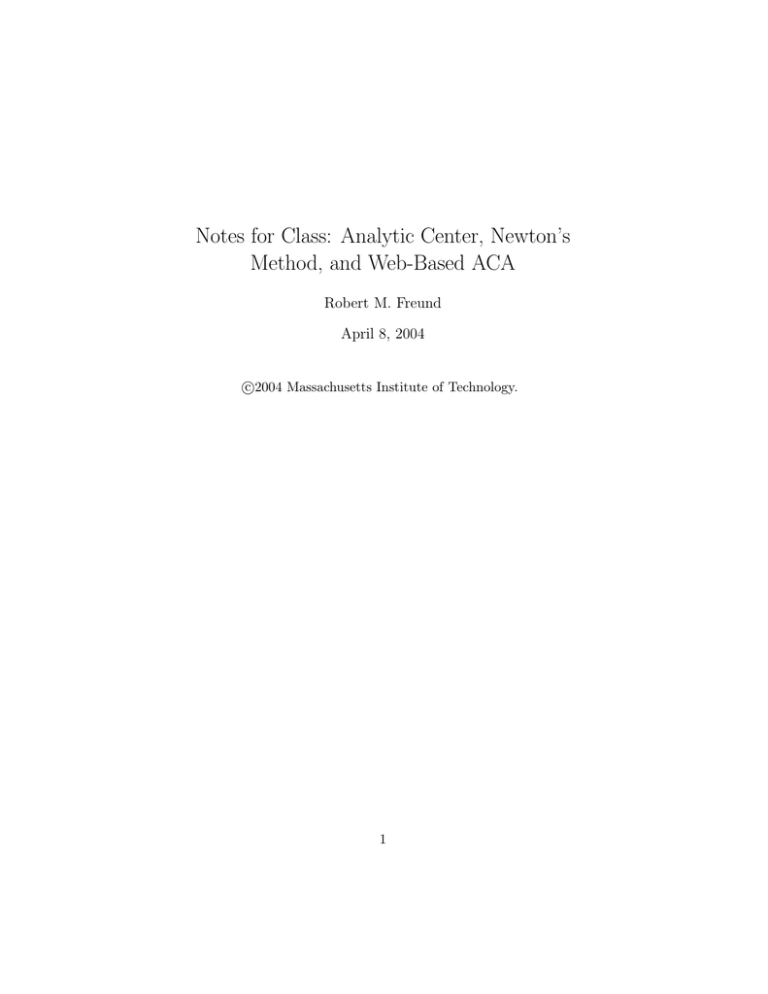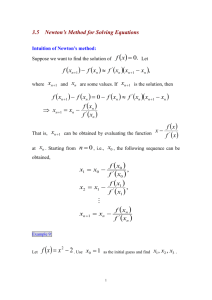Notes for Class: Analytic Center, ... Method, and Web-Based ACA
advertisement

Notes for Class: Analytic Center, Newton’s
Method, and Web-Based ACA
Robert M. Freund
April 8, 2004
c
2004
Massachusetts Institute of Technology.
1
1
The Analytic Center of a Polyhedral System
Given a polyhedral system of the form:
Ax ≤ b ,
Mx = g ,
the analytic center is the solution of the following optimization problem:
(ACP:)
m
maximizex,s
s.t.
i=1
si
Ax + s = b
s≥0
Mx = g .
This is easily seen to be the same as:
minimizex,s −
(ACP:)
s.t.
m
i=1
ln(si )
Ax + s = b
s≥0
Mx = g .
The analytic center possesses a very nice “centrality” property. Suppose
that (ˆ
x, s)
ˆ is the analytic center. Define the following matrix:
Ŝ −2
(ŝ1 )−2
0
:= ..
.
0
0
(ŝ2 )−2
...
0
2
...
...
..
.
0
0
...
. . . (ŝm )−2
.
^
x
P
Ein
Eout
Figure 1: Illustration of the Ellipsoid construction at the analytic center.
Next define the following sets:
P := {x | M x = g, Ax ≤ b}
EIN := x | M x = g,
EOUT := x | M x = g,
ˆ ≤1
(x − x)
ˆ T AT Ŝ −2 A(x − x)
(x − x)
ˆ T AT Ŝ −2 A(x − x)
ˆ ≤m
Theorem 1.1 If (ˆ
x, s)
ˆ is the analytic center, then:
EIN ⊂ P ⊂ EOUT .
This theorem is illustrated in Figure 1.
The theorem is actually pretty easy to prove.
3
Proof: Suppose that x ∈ EIN , and let s = b − Ax. Since M x = g, we need
only prove that s ≥ 0 to show that x ∈ P . By construction of EIN , s satisfies
x. This in turn can be written as:
(s − ŝ)T Ŝ −2 (s − ŝ) ≤ 1, where sˆ = b − Aˆ
m
(si − ŝi )2
i=1
ŝ2i
≤1,
whereby we see that each si must satisfy si ≥ 0. Therefore Ax ≤ b and so
x ∈ P.
We can write the optimality conditions (KKT conditions) for problem
ACP as:
−Ŝ −1 e + λ
=
0
0 + AT λ + M T u = 0
Aˆ
x + sˆ
=
b
M x̂
=
g,
where e = (1, . . . , 1)T , i.e., the e is the vector of ones.
From this we can derive the following fact: if (x, s) is feasible for problem
ACP, then
eT Ŝ −1 s = eT Sˆ−1 (b − Ax) = λT b + uT M x = λT b + uT g .
x, s)
ˆ
Since this is true for any (x, s) feasible for ACP, it will also be true for (ˆ
(where sˆ = b − Aˆ
x), and so
eT Ŝ −1 s = λT b + uT g = eT Ŝ −1 ŝ = m .
This means that s must lie in the set
T := s | s ≥ 0, eT Sˆ−1 s = m
Now the extreme points of T are simply the vectors:
4
.
v 1 := mŝ1 e1 , . . . , v m := mŝm em ,
where ei is the ith unit vector. Notice that each of these extreme points v i
satisfies:
(v i − ŝ)T Ŝ −2 (v i − ŝ) = (mei − e)T (mei − e) = m2 − m ≤ m2 ,
and so any s ∈ T will satisfy
(s − ŝ)T Ŝ −2 (s − ŝ) ≤ m2 .
Therefore for x ∈ P , s = b − Ax will satisfy
which is equivalent to
that x ∈ EOUT .
q.e.d.
2
(s − ŝ)T Ŝ −2 (s − ŝ) ≤ m,
ˆ ≤ m. This in turn implies
(x − x)
ˆ T AT Ŝ −2 A(x − x)
Newton’s Method
Suppose we want to solve:
(P:)
min f (x)
x ∈ n .
At x = x̄, f (x) can be approximated by:
1
f (x) ≈ h(x) := f (¯
x) + ∇f (¯
x)T (x − x)
¯ t H(¯
¯ + (x − x)
x)(x − x),
¯
2
which is the quadratic Taylor expansion of f (x) at x = x̄. Here ∇f (x) is
the gradient of f (x) and H(x) is the Hessian of f (x).
Notice that h(x) is a quadratic function, which is minimized by solving
∇h(x) = 0. Since the gradient of h(x) is:
∇h(x) = ∇f (¯
x) + H(¯
x)(x − x)
¯ ,
5
we therefore are motivated to solve:
∇f (¯
x) + H(¯
x)(x − x)
¯ =0,
which yields
x).
x−x
¯ = −H(¯
x)−1 ∇f (¯
x)−1 ∇f (¯
The direction −H(¯
x) is called the Newton direction, or the Newton
step at x = x̄.
This leads to the following algorithm for solving (P):
Newton’s Method:
Step 0 Given x0 , set k ← 0
Step 1 dk = −H(xk )−1 ∇f (xk ). If dk = 0, then stop.
Step 2 Choose stepsize αk = 1. Step 3 Set xk+1 ← xk + αk dk , k ← k + 1. Go to Step 1.
Note the following:
• The method assumes H(xk ) is nonsingular at each iteration.
• There is no guarantee that f (xk+1 ) ≤ f (x
k ).
• Step 2 could be augmented by a linesearch of f (xk + αdk ) to find an
optimal value of the stepsize parameter α.
Proposition 2.1 If H(x) is SPD, then d = −H(x)−1 ∇f (x) is a descent
direction, i.e. f (x + αd) < f (x) for all sufficiently small values of α.
Proof: It is sufficient to show that ∇f (x)t d = −∇f (x)t H(x)−1 ∇f (x) < 0.
This will clearly be the case if H(x)−1 is SPD. Since H(x) is SPD, if v = 0,
0 < (H(x)−1 v)t H(x)(H(x)−1 v) = v t H(x)−1 v,
thereby showing that H(x)−1 is SPD.
6
2.1
Rates of convergence
A sequence of numbers {si } exhibits linear convergence if limi→∞ si = s̄
and
|si+1 − s̄|
= δ < 1.
lim
i→∞ |si − s̄|
If δ = 0 in the above expression, the sequence exhibits superlinear convergence.
A sequence of numbers {si } exhibits quadratic convergence if limi→∞ si =
s̄ and
|si+1 − s̄|
= δ < ∞.
lim
i→∞ |si − s̄|2
Examples:
Linear convergence:
si =
1
10
i
: 0.1, 0.01, 0.001, etc. s̄ = 0.
|si+1 − s̄|
= 0.1.
|si − s̄|
Superlinear convergence:
si = i!1 : 1, 12 , 16 ,
1
1
24 , 125 ,
etc. s̄ = 0.
i!
1
|si+1 − s̄|
=
=
→ 0 as i → ∞.
|si − s̄|
(i + 1)!
i+1
(2i )
1
Quadratic convergence: si = 10
: 0.1, 0.01, 0.0001, 0.00000001, etc.
s̄ = 0.
i
|si+1 − s̄|
(102 )2
=
= 1.
|si − s̄|2
102i+1
Theorem 2.1 (Quadratic Convergence Theorem) Suppose f (x) ∈ C 3
on n (i.e., f (x) is three times continuously differentiable) and x∗ is a point
that satisfies:
∇f (x∗ ) = 0
and
H(x∗ ) is nonsingular.
If Newton’s method is started sufficiently close to x∗ , the sequence of iterates
converges quadratically to x∗ .
7
Example 1: Let f (x) = 7x − ln(x). Then ∇f (x) = f (x) = 7 − x1 and
H(x) = f (x) = x12 . It is not hard to check that x∗ = 17 = 0.142857143 is
the unique global minimum. The Newton direction at x is
−1
d = −H (x)
f (x)
1
= −x2 7 −
∇f (x) = − f (x)
x
= x − 7x2 .
Newton’s method will generate the sequence of iterates {xk } satisfying:
xk+1 = xk + (xk − 7(xk )2 ) = 2xk − 7(xk )2 .
Below are some examples of the sequences generated by this method for
different starting points.
k
0
1
2
3
4
5
6
7
8
9
10
xk
1.0
−5.0
−185.0
−239, 945.0
−4.0 × 1011
xk
0
0
0
0
0
xk
0.1
0.13
0.1417
0.14284777
0.142857142
0.142857143
xk
0.01
0.0193
0.03599257
0.062916884
0.098124028
0.128849782
0.1414837
0.142843938
0.142857142
0.142857143
0.142857143
By the way, the “range of convergence” for Newton’s method for this
function happens to be
x ∈ (0.0 , 0.2857143) .
Example 2: f (x) = − ln(1 − x1 − x2 ) − ln x1 − ln x2 .
∇f (x) =
1
1−x1 −x2
1
1−x1 −x2
8
−
1
x1
−
1
x2
,
H (x) =
x∗ =
k
0
1
2
3
4
5
6
7
1 1
3, 3
1
1−x1 −x2
2
+
1
1−x1 −x2
1
x1
2
2
1
1−x1 −x2
1
1−x1 −x2
2
2
+
1
x2
.
2
, f (x∗ ) = 3.295836866.
xk1
0.85
0.717006802721088
0.512975199133209
0.352478577567272
0.338449016006352
0.333337722134802
0.333333343617612
0.333333333333333
xk2
0.05
0.0965986394557823
0.176479706723556
0.273248784105084
0.32623807005996
0.333259330511655
0.33333332724128
0.333333333333333
xk − x∗ 0.58925565098879
0.450831061926011
0.238483249157462
0.0630610294297446
0.00874716926379655
7.41328482837195e−5
1.19532211855443e−8
1.57009245868378e−16
Some remarks:
• Note from the statement of the convergence theorem that the iterates
of Newton’s method are equally attracted to local minima and local
maxima. Indeed, the method is just trying to solve ∇f (x) = 0.
• What if H(xk ) becomes increasingly singular (or not positive definite)?
In this case, one way to “fix” this is to use H (xk ) + I.
• The work per iteration of Newton’s method is O(n3 )
• So-called “quasi-Newton methods” use approximations of H(xk ) at
each iteration in an attempt to do less work per iteration.
3
Modification of Newton’s Method with Linear
Equality Constraints
Here we consider the following problem:
9
(P:)
minimizex
f (x)
s.t.
Ax = b.
Just as in the regular version of Newton’s method, we approximate the
objective with the quadratic expansion of f (x) at x = x̄:
˜ :)
(P
x) + ∇f (¯
x)T (x − x)
¯ + 12 (x − x)
¯ t H(¯
x)(x − x)
¯
minimizex h(x) := f (¯
s.t.
Ax = b.
Now we solve this problem by applying the KKT conditions, and so we
solve the following system for (x, u):
Ax
= b
∇h(x) +AT u = 0 .
Now let us substitute the fact that:
∇h(x) = ∇f (¯
x) + H(¯
x)(x − x)
¯ and A¯
x = b.
Substituting this and replacing d = x − x̄, we have the system:
Ad
= 0
x) .
x)d +AT u = −∇f (¯
H (¯
The solution (d, u) to this system yields the Newton direction d at x̄.
10
Notice that there is actually a closed form solution to this system, if we
want to pursue this route. It is:
x) + H (¯
x)−1 AT
x)−1 AT AH (¯
d = −H(¯
x)−1 ∇f (¯
u = − AH (¯
x)−1 AT
4
−1
−1
AH(¯
x)−1 ∇f (¯
x)
AH(¯
x) .
x)−1 ∇f (¯
Web-Based ACA (Adaptive Conjoint Analysis)
11





